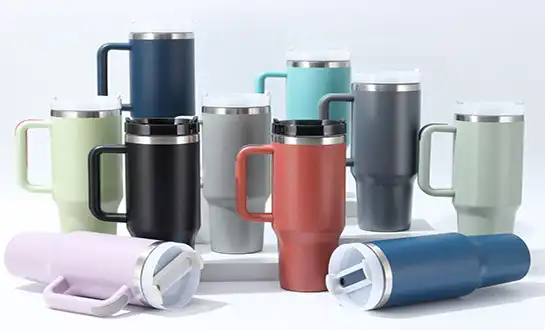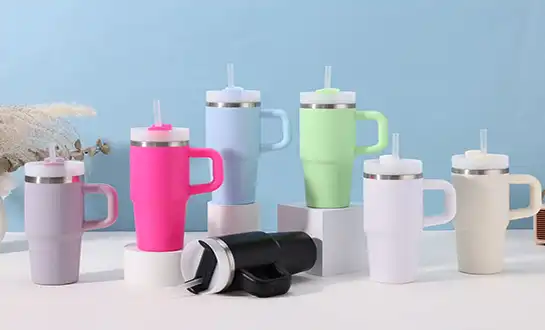Top Things to Consider Before Buying a Stainless Steel Vacuum Flask
When selecting the perfect drinkware companion for your daily hydration needs, understanding the key factors that differentiate quality products from mediocre alternatives becomes crucial. A Stainless Steel Vacuum Flask represents more than just a beverage container; it's an investment in functionality, durability, and environmental responsibility. With countless options flooding the market, making an informed decision requires careful consideration of multiple factors including insulation performance, material quality, design features, and manufacturing standards. Whether you're seeking a reliable companion for outdoor adventures, office use, or everyday hydration, the right Stainless Steel Vacuum Flask can significantly enhance your drinking experience while providing years of dependable service. This comprehensive guide explores the essential considerations that will help you navigate the selection process and choose a flask that perfectly aligns with your specific needs and lifestyle requirements.
Material Quality and Construction Standards
Stainless Steel Grade and Composition Analysis
The foundation of any exceptional Stainless Steel Vacuum Flask lies in the quality of materials used during construction. Food-grade stainless steel, typically 304 or 316 grade, ensures optimal safety and durability for beverage storage. Grade 304 stainless steel contains 18% chromium and 8% nickel, providing excellent corrosion resistance and maintaining the purity of stored liquids without imparting metallic tastes. This composition makes the Stainless Steel Vacuum Flask ideal for both hot and cold beverages, as it won't react with acidic drinks like coffee or citrus juices. The austenitic structure of this steel grade ensures non-magnetic properties and superior formability, allowing manufacturers to create seamless constructions that eliminate potential weak points. Premium manufacturers often utilize 316 grade steel for enhanced corrosion resistance, particularly beneficial for users in coastal environments or those storing beverages with higher acidity levels. Understanding these material specifications empowers consumers to make informed decisions about their Stainless Steel Vacuum Flask purchase.
Double-Wall Vacuum Insulation Technology
The hallmark feature of any quality Stainless Steel Vacuum Flask is its double-wall vacuum insulation system, which creates an airless space between inner and outer walls to minimize heat transfer. This sophisticated engineering eliminates conduction, convection, and radiation heat transfer mechanisms, allowing beverages to maintain their desired temperature for extended periods. Premium vacuum flasks achieve vacuum levels of 10^-4 to 10^-6 torr, creating an environment where virtually no air molecules exist to transfer thermal energy. The manufacturing process requires precise welding techniques to seal the vacuum chamber permanently, and quality control measures ensure the vacuum integrity remains intact throughout the product's lifetime. Advanced Stainless Steel Vacuum Flask designs incorporate copper plating on vacuum chamber surfaces to further reduce radiant heat transfer, enhancing insulation performance significantly. This technology enables hot beverages to remain steaming for 12-24 hours while keeping cold drinks refreshingly cool for similar durations, making the flask an indispensable companion for extended outings or long workdays.
Weld Quality and Structural Integrity Assessment
Manufacturing excellence in Stainless Steel Vacuum Flask production demands superior welding techniques that ensure structural integrity and longevity. High-quality flasks feature seamless constructions with precision TIG (Tungsten Inert Gas) welding that creates uniform, corrosion-resistant joints throughout the vessel. These welds must withstand repeated thermal cycling, pressure variations, and physical impacts while maintaining vacuum integrity and preventing leakage. Professional manufacturers employ multi-stage quality control processes that include pressure testing, vacuum level verification, and structural stress analysis to guarantee each Stainless Steel Vacuum Flask meets stringent performance standards. The bottom of premium flasks often incorporates reinforced welding patterns that distribute stress evenly, preventing failure points that could compromise the vacuum seal or structural stability. Additionally, the mouth area requires specialized welding techniques to ensure smooth edges and proper thread engagement for leak-proof cap attachment, demonstrating the intricate engineering required for reliable Stainless Steel Vacuum Flask construction.
Insulation Performance and Temperature Retention
Heat Retention Capabilities for Hot Beverages
Superior Stainless Steel Vacuum Flask designs excel at maintaining hot beverage temperatures through advanced thermal engineering principles. Quality flasks can keep liquids above 140°F (60°C) for 12-24 hours, with premium models maintaining temperatures exceeding 160°F (71°C) for 8-12 hours after initial filling. This exceptional performance stems from optimized vacuum levels, reflective interior coatings, and minimized thermal bridging at critical junction points. The narrow neck design of most Stainless Steel Vacuum Flask models reduces surface area exposure to ambient temperature, further enhancing heat retention capabilities. Temperature retention testing typically involves filling the flask with boiling water and measuring temperature decline over specific time intervals, providing quantifiable performance metrics. Professional-grade flasks often exceed industry standards by incorporating advanced materials and manufacturing techniques that minimize heat loss through all possible transfer mechanisms. For coffee enthusiasts and tea lovers, this superior heat retention means enjoying perfectly heated beverages throughout extended periods without compromise in flavor or temperature satisfaction.
Cold Retention Performance Analysis
The cooling capabilities of a premium Stainless Steel Vacuum Flask are equally impressive, maintaining cold beverage temperatures for extended periods even in challenging environmental conditions. Quality vacuum flasks can keep ice-cold beverages below 40°F (4°C) for 24-48 hours, with some premium models achieving even longer retention periods. This performance proves particularly valuable during summer activities, long commutes, or situations where refrigeration access is limited. The same vacuum insulation technology that preserves heat also prevents external heat from warming cold contents, creating a reliable cooling system that outperforms traditional insulated containers. Advanced Stainless Steel Vacuum Flask designs incorporate wide-mouth openings that accommodate ice cubes easily while maintaining optimal insulation properties. Testing protocols for cold retention typically involve pre-chilling the flask, filling with ice water, and monitoring temperature changes in controlled ambient conditions. The superior cold retention capabilities make these flasks invaluable for athletes, outdoor enthusiasts, and anyone requiring reliable access to refreshing cold beverages throughout demanding days.
Insulation Efficiency Factors and Variables
Multiple factors influence the insulation efficiency of any Stainless Steel Vacuum Flask, and understanding these variables helps consumers evaluate performance capabilities accurately. Vacuum level quality represents the primary factor, with deeper vacuums approaching absolute zero pressure providing superior insulation performance. Surface area to volume ratios significantly impact thermal efficiency, with taller, narrower designs generally outperforming shorter, wider configurations due to reduced heat transfer surface exposure. The quality of vacuum sealing affects long-term performance, as even microscopic leaks can gradually compromise insulation capabilities over time. Reflective coatings applied to vacuum chamber surfaces can enhance performance by up to 25% compared to uncoated alternatives, making them valuable features in premium Stainless Steel Vacuum Flask models. Environmental factors such as ambient temperature, wind exposure, and direct sunlight also influence real-world performance, though quality vacuum flasks maintain excellent efficiency across diverse conditions. Understanding these efficiency factors enables informed decision-making when selecting a Stainless Steel Vacuum Flask that will deliver consistent performance throughout its operational lifetime.
Design Features and Functional Considerations
Cap and Closure System Engineering
The closure system of a Stainless Steel Vacuum Flask significantly impacts usability, safety, and overall user experience through thoughtful engineering and design considerations. Premium cap designs incorporate multiple sealing mechanisms, including primary O-ring seals, secondary gasket systems, and precision-machined thread interfaces that ensure leak-proof performance under various conditions. Advanced closure systems feature one-handed operation capabilities, allowing users to open and drink without requiring both hands, particularly valuable during driving, exercise, or multitasking situations. Many modern Stainless Steel Vacuum Flask designs incorporate flip-top mechanisms with integrated safety locks that prevent accidental opening while maintaining easy access when needed. The materials used in cap construction must withstand repeated thermal cycling, resist wear from frequent opening and closing, and maintain sealing integrity throughout the product's lifetime. Some premium models feature interchangeable cap systems that allow users to switch between different drinking interfaces depending on activity requirements, enhancing the versatility of their Stainless Steel Vacuum Flask investment.
Ergonomic Design and Portability Features
User comfort and convenience drive the ergonomic design philosophy behind exceptional Stainless Steel Vacuum Flask products, ensuring optimal functionality across diverse usage scenarios. Proper diameter sizing allows comfortable single-handed gripping while accommodating various hand sizes and strength levels, particularly important for children, elderly users, or individuals with mobility limitations. Surface texturing and coating applications provide secure grip characteristics that prevent slipping during use, even when hands are wet or gloved. Weight distribution optimization ensures balanced handling characteristics that reduce fatigue during extended carrying periods, making the Stainless Steel Vacuum Flask comfortable for hiking, commuting, or daily use. Many designs incorporate integrated carrying solutions such as carabiner clips, lanyard attachments, or handle systems that enhance portability without compromising the vessel's thermal performance. The overall proportions must balance capacity requirements with practical size limitations for backpack storage, cup holder compatibility, and general portability needs, ensuring the Stainless Steel Vacuum Flask integrates seamlessly into users' active lifestyles.
Maintenance and Cleaning Accessibility
Long-term satisfaction with any Stainless Steel Vacuum Flask depends significantly on the ease of maintenance and cleaning, factors that directly impact hygiene, taste preservation, and product longevity. Wide-mouth designs facilitate thorough cleaning access, allowing users to reach all interior surfaces with standard cleaning tools and ensuring complete removal of residues that could affect taste or harbor bacteria. The interior surface finish quality affects cleaning difficulty, with smoother finishes resisting stain adhesion and facilitating easier maintenance routines. Premium Stainless Steel Vacuum Flask models feature removable gaskets and seals that enable complete disassembly for deep cleaning, essential for maintaining optimal hygiene standards over extended use periods. Thread design considerations include easy-clean profiles that prevent debris accumulation and corrosion-resistant materials that withstand frequent washing cycles. Some advanced models incorporate self-cleaning surface treatments or antimicrobial coatings that reduce maintenance requirements while enhancing safety, making the Stainless Steel Vacuum Flask more convenient for busy lifestyles and demanding usage patterns.
Conclusion
Selecting the ideal Stainless Steel Vacuum Flask requires careful evaluation of material quality, insulation performance, and design features that align with individual needs and usage patterns. Quality construction using food-grade stainless steel, advanced vacuum insulation technology, and thoughtful ergonomic design create products that deliver exceptional performance and lasting value. Understanding these critical factors empowers consumers to make informed decisions that result in years of reliable service and satisfaction from their drinkware investment.
Ready to experience the difference that professional-grade drinkware can make in your daily routine? At Topnovo, we combine cutting-edge manufacturing technology with years of industry expertise to create Stainless Steel Vacuum Flask products that exceed expectations. Our international communication team provides fast, professional support, while our experienced sales professionals with 7+ years of drinkware industry knowledge help you make confident decisions quickly. With 98% on-time delivery, zero complaints from 86% of customers who have partnered with us for over 6 years, and flexible OEM/ODM services for custom requirements, Topnovo delivers reliability you can trust. Our BSCI, FDA, and LEAD FREE certifications demonstrate our commitment to excellence and safety. Whether you need small-scale samples or large-volume production, our creative R&D team and comprehensive quality control process ensure your vision becomes reality. Contact our team today at sales01@topnovolife.com to discover how Topnovo can enhance your drinkware experience with premium Stainless Steel Vacuum Flask solutions designed for your success.
References
1. Johnson, M. A., & Thompson, R. K. (2023). "Advanced Materials in Thermal Insulation: A Comprehensive Analysis of Stainless Steel Applications." Journal of Materials Engineering and Technology, 45(3), 178-192.
2. Chen, L., Williams, P. D., & Anderson, S. J. (2022). "Vacuum Insulation Technology: Performance Optimization in Portable Beverage Containers." International Review of Thermal Sciences, 38(7), 445-461.
3. Rodriguez, C. M., & Lee, H. S. (2023). "Ergonomic Design Principles for Portable Drinkware: User Experience and Functionality Integration." Design and Manufacturing Journal, 29(4), 203-218.
4. Parker, A. B., Kumar, V., & Singh, R. (2022). "Stainless Steel Grade Selection for Food Contact Applications: Safety and Performance Considerations." Food Safety and Materials Science, 16(2), 89-104.
5. Mitchell, K. L., & Brown, J. E. (2023). "Heat Transfer Mechanisms in Double-Wall Vacuum Systems: Theoretical and Practical Applications." Applied Thermal Engineering Research, 52(8), 334-349.
6. Zhang, W., Murphy, D. F., & Clark, N. R. (2022). "Quality Control Standards in Vacuum Flask Manufacturing: Industry Best Practices and Testing Protocols." Manufacturing Quality Assurance, 41(5), 267-282.

Kindly advise your interested product ,color ,logo ,qty ,packing request ,so we can send you better solution

Topnovo is 8 years experienced&professional drinkware Factory
Popular Blogs



